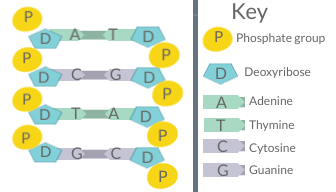Chargaff’s Rule states that in a double-stranded DNA molecule, the amount of adenine (A) always equals the amount of thymine (T), and the amount of cytosine (C) always equals the amount of guanine (G). This principle of base pairing ensures the structural integrity and replication fidelity of DNA across all living organisms. This blog post explains the fundamentals of Chargaff’s Rule and how it is utilized in the study of structure of DNA.
Introduction
- DNA is the fundamental molecule that encodes genetic information in all living organisms.
- It consists of two strands forming a double helix, composed of four nitrogenous bases: adenine (A), thymine (T), cytosine (C), and guanine (G).
- The organization of these bases follows specific rules that ensure genetic fidelity.
- Chargaff’s Rule is a foundational principle that explains the proportional relationships between these bases.
- Understanding Chargaff’s Rule is crucial for comprehending DNA replication, genetic inheritance, and molecular biology advancements.
- The discovery of this rule was instrumental in the elucidation of DNA’s structure by Watson and Crick.

The Work of Erwin Chargaff
- Erwin Chargaff was an Austrian-American biochemist known for his groundbreaking work in nucleic acids.
- Born in 1905, Chargaff pursued a career in chemistry, eventually focusing on the chemical composition of DNA.
- His research in the 1940s revealed critical patterns in nucleotide composition across different organisms.
- Through meticulous experimentation, he discovered consistent ratios between adenine and thymine, as well as cytosine and guanine.
- His findings challenged prevailing scientific notions and set the stage for the discovery of the DNA double helix.
| You may also like NOTES in... | ||
|---|---|---|
| BOTANY | BIOCHEMISTRY | MOL. BIOLOGY |
| ZOOLOGY | MICROBIOLOGY | BIOSTATISTICS |
| ECOLOGY | IMMUNOLOGY | BIOTECHNOLOGY |
| GENETICS | EMBRYOLOGY | PHYSIOLOGY |
| EVOLUTION | BIOPHYSICS | BIOINFORMATICS |
Understanding the Basics: What is Chargaff’s Rule?
- Chargaff’s Rule describes the equivalence of specific nitrogenous bases in DNA.
- It consists of two key principles:
- The amount of adenine is always equal to the amount of thymine (A = T).
- The amount of cytosine is always equal to the amount of guanine (C = G).
- These relationships ensure the complementary nature of the DNA strands.
- The rule applies universally to almost all known organisms, demonstrating its fundamental biological significance.
- Chargaff’s Rule was instrumental in the discovery of DNA’s helical structure, providing empirical support for base pairing.

Christinelmiller, CC BY 4.0, via Wikimedia Commons
Chargaff’s First Parity Rule: Base Pairing Explained
- The first parity rule states that within a given DNA molecule:
- The number of adenine bases is equal to the number of thymine bases.
- The number of cytosine bases is equal to the number of guanine bases.
- This principle is a cornerstone of DNA’s structure, ensuring the integrity of genetic information.
- Adenine pairs with thymine via two hydrogen bonds, while cytosine pairs with guanine via three hydrogen bonds.
- These pairings contribute to the stability and consistency of the double helix.
Chargaff’s Second Parity Rule: Beyond Base Pairing
- The second parity rule applies to single DNA strands rather than double-stranded DNA.
- It states that the composition of bases remains relatively balanced within each DNA strand.
- This principle is more complex and has been subject to further study in evolutionary genetics.
- While the first rule is universal, the second rule has notable exceptions in certain species.
- Understanding this rule has implications for studying genetic asymmetry and mutation rates.
Experimental Evidence Supporting Chargaff’s Rule
- Chargaff conducted extensive experiments to analyze DNA composition across species.
- He used paper chromatography and ultraviolet spectrophotometry to quantify base ratios.
- His findings demonstrated that base pair ratios were consistent in organisms from bacteria to humans.
- These results provided empirical evidence that challenged previous assumptions about DNA uniformity.
- Chargaff’s data laid the groundwork for Watson and Crick’s double helix model.
The Role of Chargaff’s Rule in DNA Replication and Function
- DNA replication depends on the principle of complementary base pairing.
- The equal proportions of bases ensure accurate copying of genetic material.
- Any deviation from the expected ratios can result in mutations and genomic instability.
- Chargaff’s findings help explain the fidelity of DNA replication and inheritance.
- His work remains essential for understanding how genetic information is preserved across generations.
Exceptions to Chargaff’s Rule and Their Implications
- While Chargaff’s Rule applies broadly, some exceptions exist.
- Mitochondrial DNA and some viral genomes do not strictly follow the base pairing ratios.
- Certain bacterial and archaeal genomes exhibit deviations due to evolutionary adaptations.
- These exceptions provide insights into non-coding DNA and genome organization.
- Studying these anomalies helps refine our understanding of genetic variation and evolution.
Modern Applications of Chargaff’s Rule in Genetics
- Chargaff’s Rule continues to influence various fields of molecular biology.
- In DNA sequencing, base composition analysis helps identify genetic variations.
- In forensic science, DNA profiling relies on base pair recognition to establish identities.
- Bioinformatics uses Chargaff’s principles to analyze and compare genomes computationally.
- The rule remains integral to genetic engineering, medical research, and evolutionary biology.
Criticism, Limitations, and Ongoing Research
- Some scientists argue that Chargaff’s Rule oversimplifies DNA composition in certain organisms.
- Non-coding regions and repetitive sequences do not always adhere to the expected ratios.
- Modern research explores the role of epigenetics and chemical modifications in DNA structure.
- Studies continue to investigate the rule’s relevance in RNA-based organisms.
- Despite limitations, Chargaff’s Rule remains a foundational concept in genetic science.
Conclusion
- Chargaff’s Rule transformed our understanding of DNA and molecular biology.
- It provided crucial insights that led to the discovery of the DNA double helix.
- The rule remains fundamental in genetics, guiding research in replication, sequencing, and forensic science.
- Although exceptions exist, its principles continue to shape our knowledge of biological inheritance.
- Chargaff’s contributions endure as a testament to the power of empirical observation in scientific discovery.
<<< Back to Molecular Biology Notes
FAQ on Chargaff Rule
(1). What is Chargaff’s Rule?
Chargaff’s Rule states that in double-stranded DNA, the amount of adenine (A) equals thymine (T), and the amount of cytosine (C) equals guanine (G).
(1). How was Chargaff’s Rule discovered?
Erwin Chargaff analyzed the DNA of various species in the late 1940s and found a consistent pattern in nucleotide composition.
(3). What are the basics of Chargaff’s Rule?
The rule highlights base-pairing regularities, with A pairing with T and C pairing with G, crucial for DNA structure and replication.
(4). What are Chargaff’s First and Second Parity Rules?
The first rule states A = T and C = G in double-stranded DNA, while the second rule suggests similar nucleotide distribution in single-stranded DNA.
(5). What experimental evidence supports Chargaff’s Rule?
Chargaff’s chromatographic studies across multiple species confirmed base pair ratios, laying the foundation for Watson and Crick’s DNA model.
(6). What is the role of Chargaff’s Rule in DNA replication and its functions?
The rule ensures complementary base pairing, enabling accurate DNA replication and genetic information transfer.
(7). What are the exceptions to Chargaff’s Rule, and what are their implications?
Exceptions occur in single-stranded viruses and organelle DNA, suggesting variations in replication mechanisms and evolutionary adaptations.
| You may also like... | ||
|---|---|---|
| NOTES | QUESTION BANK | COMPETITIVE EXAMS. |
| PPTs | UNIVERSITY EXAMS | DIFFERENCE BETWEEN.. |
| MCQs | PLUS ONE BIOLOGY | NEWS & JOBS |
| MOCK TESTS | PLUS TWO BIOLOGY | PRACTICAL |
